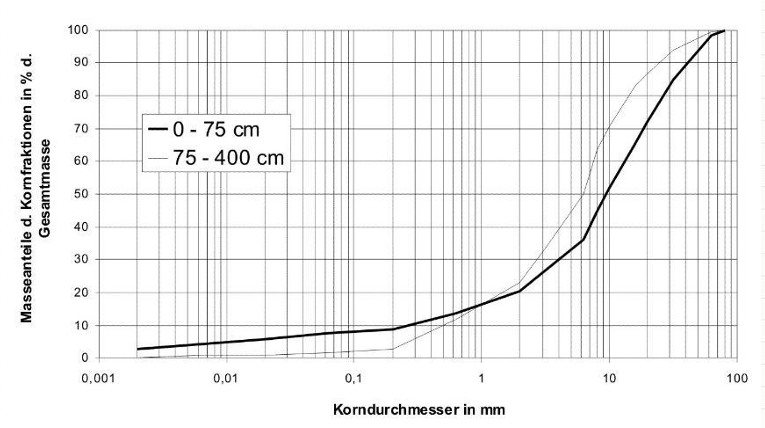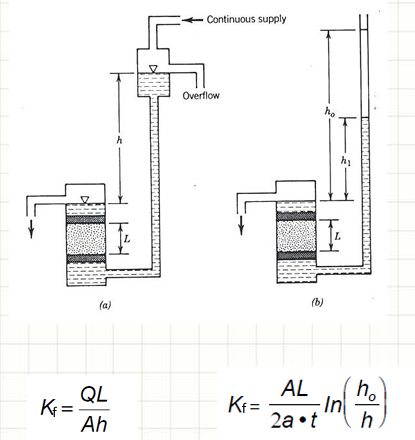3. Methods for determining hydraulic conductivity + Tracer methods
1/14
There's no tags or description
Looks like no tags are added yet.
Name | Mastery | Learn | Test | Matching | Spaced |
|---|
No study sessions yet.
15 Terms
Why are hydraulic properties of groundwater important?
Slope stability and seepage (Versickerung) control
planning of control and monitoring measures for geotechnical projects
Drainage for open pit mines
Effects of seepage water from mine tailings
Barrier wells and control barriers (for conatminated groundwater)
Environmental impact assessment
planning of suitable drinking water wells or site for landfills
What methods exist to determine groundwater properties?
calculated from the grain size curves
laboratory methods
field methods
How does the grain size curve function?
e.g. d10 is the grain diameter at which 10% of the sample is finer than the respective grain size value

What is considered when calculating hydraulic properties from the grain size curve?
considering:
packing type (how much space is between the graines?)
Uniformity coefficient Cu=d60/d10 → how uniform is the sample?
Coefficient of curvature Cc = (d302 / d60*d10)
Soils are considered uniform if Cu < 4 and Cc between 1-3
lower uniformity → higher dispersivity
Temperature
increase of T leads to decrease of viscosity, which again leads to increase of kf

Formulas to calculate the hydraulic conductivity from grain size curve.
Kozeny formula
good for homogenous material e.g. river sand
Takes porosity, grain shape factor (r), and viscosity into account
Therzagi formula
used for very fine clay
Beyer & Schweiger formula
can be used for everything
includes the uniformity coefficient CU
Hazel formula
only used for fine, uniform material CU < 4
Labaroty methods - Porosity
Sand: 0.26-0.43
Organic clay: 0.5-0.75
→ clay has much more pores altough much smaller than sand and hence porosity is larger (porosity ≠ permeability)!!

Laboratory method - Permeameter

Difference between Permeability (K) vs. Hydraulic Conductivity kf
K [m2] only depends on the material
kf [m/s] depends on material and fluid flowing through it
![<ul><li><p>K [m<sup>2</sup>] only depends on the material</p></li><li><p>k<sub>f </sub>[m/s] depends on material and fluid flowing through it</p></li></ul><p></p>](https://knowt-user-attachments.s3.amazonaws.com/11bc0919-18fd-4c82-90db-d065450bb9ff.png)
Why do we need tracer tests? What are fields of application?
to determine…
source of water
subsurface flow paths
flow directions
flow velocity
catchment areas
residence times
mixing processes (e.g. with surface water)
discharge rates
contaminant transport processess
applications:
Fractured, pore, and karst aquifers
Unsaturated (vadose) and saturated zone
Rivers, streams, lakes, glaciers
Column tests in the laboratory
Explain the transport mechanisms in the soil. Why does dispersion change with scale?
Advection
mass transport with water flow
Dispersion
mass transport due to velocity fluctuations
Diffusion
mass transport due to concentration gradient
Reactions (chemical/biological processes)
Dispersion increases with scale because aquifer heterogeneity causes more complex flow paths over long distances
What types of tracer tests do you know?
Simple tracer test
to characterize flow paths
1 input location, 1 tracer, 1 or more sampling sites
Combined tracer test
to determine boundaries of catchment area
with different tracers at different input points
Comparative tracer test
simultaneous introduction of different tracers at one input location
Repeated tracer test
same test setup at different discharge conditions
What types or tracers do you know?
Artificial
uranine, bromide
colloidal tracers (mimic microorganisms or particles in groundwater e.g. bacteriophages or spores)
DNA based tracers (free or encapsulated)
Natural
isotopes
Salt NaCl
chemical tracers e.g. PFAS
Pharamceuticals…
Other classification of Tracers
fluorescent tracers (Uranine)
Salt tracers
chemical tracers
stable and radioactive isotopes (e.g. Deuterium)
Fluorescent tracer
organic substance containing aromatic groups and exhibiting the optical property of fluorescence
good: very low detection limit
bad: can sorb especially to gravel
What is the transport of pathogenic Viruses in Groundwater depending on
water saturation
flow rate
ionic strength and pH